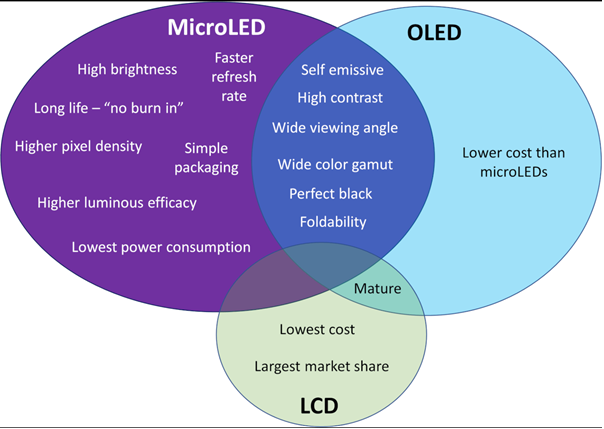microLED technology
Context: Apple’s shift to microLED display technology is reportedly under process. Considered as the next big transition in display technology, microLEDs are self-illuminating diodes that have brighter and better colour reproduction than Organic Light Emitting Diode (OLED) display technology.
The company is currently working on this new display technology and plans to implement the same on future watch models starting 2024, and gradually to its other devices including iPhones and Macs.
What is microLED display technology?
- The basis of microLED technology are sapphires. A sapphire can shine on its own forever.
- A microLED screen is filled with such small but strong light. The picture in a microLED screen is generated by several individual light-emitting diodes.
- MicroLED is as small as cutting a centimetre of hair into 200 smaller pieces.
- Each of these microLEDs are semiconductors that receive electric signals. Once these microLEDs are gathered, they form a module. Several modules are then combined to form screens.
What are its benefits over other displays?
- MicroLED displays are brighter, have better colour reproduction and provide better viewing angles.
- They make images appear as if they painted on top of the device’s glass and are quite the technological feat.
- MicroLEDs have limitless scalability, as they are resolution-free, bezel-free, ratio-free, and even size-free.
- The screen can be freely resized in any form for practical usage. In addition to being self-emissive, MicroLEDs also individually produce red, green, and blue colours without needing the same backlighting or colour filters as conventional displays
- Samsung and LG Displays have evolved with brighter OLED panels over the last couple of years but microLED promises even greater luminance without panel degradation issues.
When did Apple start working on this tech?
- Apple started working on the tech in 2014 after purchasing startup LuxVue that pioneered microLED technology.
- The development of Apple’s microLED screens was led by veteran executive Lynn Youngs within Apple’s hardware engineering division, but the project was moved to the purview of Johny Srouji, Senior Vice President of Hardware Technologies at Apple.
- The project is now being led by Wei Chen, who runs Apple’s display technology group within Srouji’s Hardware Technologies division.
- The company has started testing microLED displays on its Watch Ultra.
| What OLED Display?
● ‘OLED’ stands for Organic Light-Emitting Diode – a technology that uses LEDs in which the light is produced by organic molecules. ● These organic LEDs are used to create what are considered to be the world’s best display panels.
● OLED displays are made by placing a series of organic thin films between two conductors. When an electrical current is applied, a bright light is emitted. ● OLEDs enable emissive displays – which means that each pixel is controlled individually and emits its own light (unlike LCDs in which the light comes from a backlighting unit). ● OLED displays feature great image quality – bright colours, fast motion and most importantly – very high contrast. ○ Most notably, “real” blacks (that cannot be achieved in LCDs due to the backlighting). ○ The simple OLED design also means that it is relatively easy to produce flexible and transparent displays.
|
| Practice Question
|





